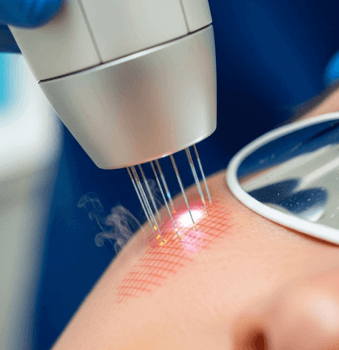Treatment Overview
The CO₂ Fractional Laser is a powerful dermatology treatment in Korea used for stubborn pigmentation, scars, wrinkles, texture issues, and photoaging.
For Post-Inflammatory Hyperpigmentation (PIH) — the dark marks left after acne, inflammation, or injury — the CO₂ Laser is not usually the first-line treatment (since gentler options like Nd:YAG or Pico are preferred for Asian skin). However, when PIH is deep, stubborn, or combined with scars/texture damage, Korean dermatologists may recommend fractional CO₂ resurfacing.
The CO₂ laser works by creating controlled microscopic columns of ablation and heat in the skin. This removes damaged pigmented cells and stimulates regeneration of new skin with healthier tone and texture.
Purpose & Benefits
- PIH Clearance: Vaporizes pigmented skin cells and encourages new skin growth.
- Scar & Texture Repair: Improves acne scars, roughness, and enlarged pores.
- Wrinkle Reduction: Collagen stimulation improves fine lines alongside pigmentation.
- Long-Lasting Results: Stronger and more dramatic compared to non-ablative lasers.
- Multi-Action: Treats pigment, texture, and aging in one procedure.
Ideal Candidates
CO₂ Laser in Korea is recommended for:
- Patients with PIH + acne scars/texture issues.
- Adults with deep, stubborn pigmentation that hasn’t responded to milder treatments.
- Individuals seeking comprehensive skin renewal rather than pigment-only care.
Possible Risks & Complications
Because CO₂ is more aggressive, risks are higher than with toning or Pico lasers:
- Redness & Swelling: Lasts several days to 1 week.
- Scabbing/Crusting: Pigmented areas flake or peel during healing.
- Dryness & Sensitivity: New skin may feel tender for weeks.
- Temporary Darkening: Spots may darken before clearing.
- PIH Risk: Can trigger new hyperpigmentation if aftercare is neglected (why Korean dermatologists use conservative, fractional settings for Asian skin).
Surgical Techniques Used
- Fractional CO₂ Laser: Creates micro-columns of ablation, leaving surrounding tissue intact for faster healing.
- Spot Ablation Mode: Directly removes pigmented lesions or acne scars.
- Combination Protocols: Often paired with Pico, toning lasers, or brightening drips for safer PIH clearance.
- Protocol: Usually 1–3 sessions, spaced 6–8 weeks apart.
Recovery & Aftercare
- Immediately: Redness, swelling, stinging.
- 1–3 Days: Scabbing/crusting over pigmented areas.
- 1 Week: Brighter, clearer skin appears.
- 2–4 Weeks: Continued healing with improved PIH and texture.
Aftercare Tips:
- Apply SPF 50+ sunscreen daily — essential to prevent new PIH.
- Use healing creams and barrier ointments as prescribed.
- Avoid makeup until skin barrier recovers (usually 3–5 days).
- No scrubbing or picking at crusts.
- Minimize sun exposure for at least 2–3 weeks post-treatment.
Results & Longevity
- After 1 Session: Significant improvement in scars + fading of PIH.
- 2–3 Sessions: Major clearance of stubborn pigment with smoother texture.
- Long-Term: Results can last 1–2 years; maintenance may be needed if new acne or inflammation occurs.
Treatment Process in Korea
Korea is considered a world leader in fractional CO₂ protocols for Asian skin, using advanced techniques to minimize downtime and PIH risk.
- Consultation & Skin Analysis
- Dermatologist evaluates PIH depth and scarring severity.
- CO₂ recommended if PIH is accompanied by texture/scarring.
- Preparation
- Skin cleansing + topical numbing cream (30–40 minutes).
- Protective eyewear provided.
- CO₂ Laser Session
- Fractional passes over PIH areas and scarred regions.
- Spot ablation for stubborn pigmented lesions.
- Session lasts 20–30 minutes depending on the treated area.
- Post-Treatment Care
- Cooling therapy and repair cream applied.
- Sunscreen emphasized.
- Optional brightening serums or whitening drips for faster PIH clearance.
- Follow-Up
- Typically 1–3 sessions spaced 6–8 weeks apart.
- Often combined with Pico, Nd:YAG toning, or boosters (Rejuran, exosomes) for better pigment control.
Unique Korean Advantages:
- Fractional, low-density protocols: Reduce PIH risk in Asian skin.
- Combination Programs: CO₂ + Pico or CO₂ + Fraxel for pigment + scars.
- Advanced Devices: Korean clinics use state-of-the-art fractional CO₂ systems.
- Comprehensive Care: Packages often include post-laser skin boosters and whitening drips.
Cost Range (Estimated)
- Single Session (Full Face): USD 250 – 500
- 2–3 Session Package: USD 700 – 1,200
- Premium Combination Program (CO₂ + Pico/Fraxel/Boosters): USD 1,500 – 3,000
Additional Costs:
- Consultation: USD 20 – 50
- Add-ons:
- Whitening drips (Glutathione, Vitamin C): USD 100 – 200
- Skin boosters (Rejuran, PN, exosomes): USD 150 – 400
- Post-laser healing kits: USD 50 – 100
Example Korean Programs:
- Basic CO₂ Package (1–2 sessions): USD 500–800
- Advanced PIH & Scar Program (CO₂ + Pico): USD 1,200–1,600
- Premium Anti-Aging Pigment Program (CO₂ + Fraxel + Rejuran): USD 2,000–3,000
Popular Clinics in Seoul
- Oracle Dermatology: CO₂ + Pico for acne PIH + scars.
- Banobagi Dermatology: CO₂ resurfacing for pigment + wrinkles.
- Renewme Skin Clinic: Fractional CO₂ + whitening serums for PIH.
- View Plastic & Dermatology: CO₂ + Fraxel for pigment + texture repair.
- Chaum Anti-Aging Center: Premium CO₂ programs with regenerative boosters.




